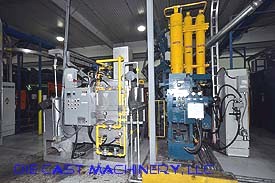 The Die Cast Process
The Die Cast Process
Die casting involves pouring molten metal into a mold, then allowing it to cool and solidify. The solidified product is called a cast. Metal is heated until molten in a furnace. Pure forms of the primary metal used to form an alloy is referred to as virgin material. Virgin material along with scrap metal and alloys are used to charge the furnace.
A number of specialized furnaces are used to heat the metal. Furnace types include reverberatory, electric arc furnaces (EAF), induction furnaces, cupolas, and crucible furnaces. The furnace used is determined by  the metal to be melted. Reverberatory and crucible furnaces are the most common and typically used for aluminum, bronze, and brass castings.
the metal to be melted. Reverberatory and crucible furnaces are the most common and typically used for aluminum, bronze, and brass castings.
Once the mold has been removed, the cast must be degated. Degating is the process of removing the heads, runners, gates, and risers from the casting. These can be removed by torches or bandsaws. For some casts, runners and gates can be removed by breaking them away with a hammer or specially knockout machine. The degating process creates a more finished product.
Furnaces can range in size from small ones used to melt a few pounds to furnaces weighing several tons, capable of melting hundreds of pounds of scrap at a time. They are designed according to the type of metals that are to be melted. The furnace designer will choose the fuel type based on the amount of heat required to melt the metal. Electric, propane or natural gas powered furnaces are used for low temperature melting metals such as zinc or tin. Electricity or coke is used to melt high melting point metals such as steel or nickel based alloys.
